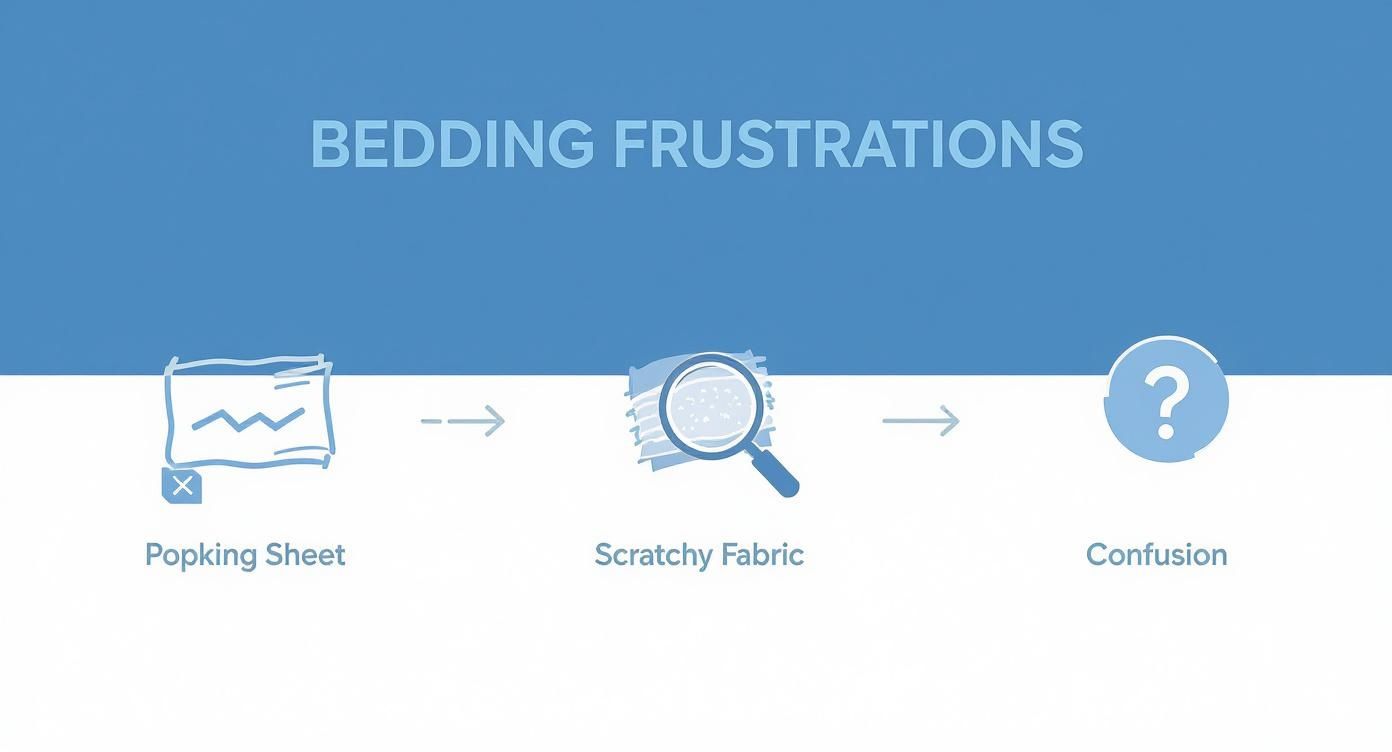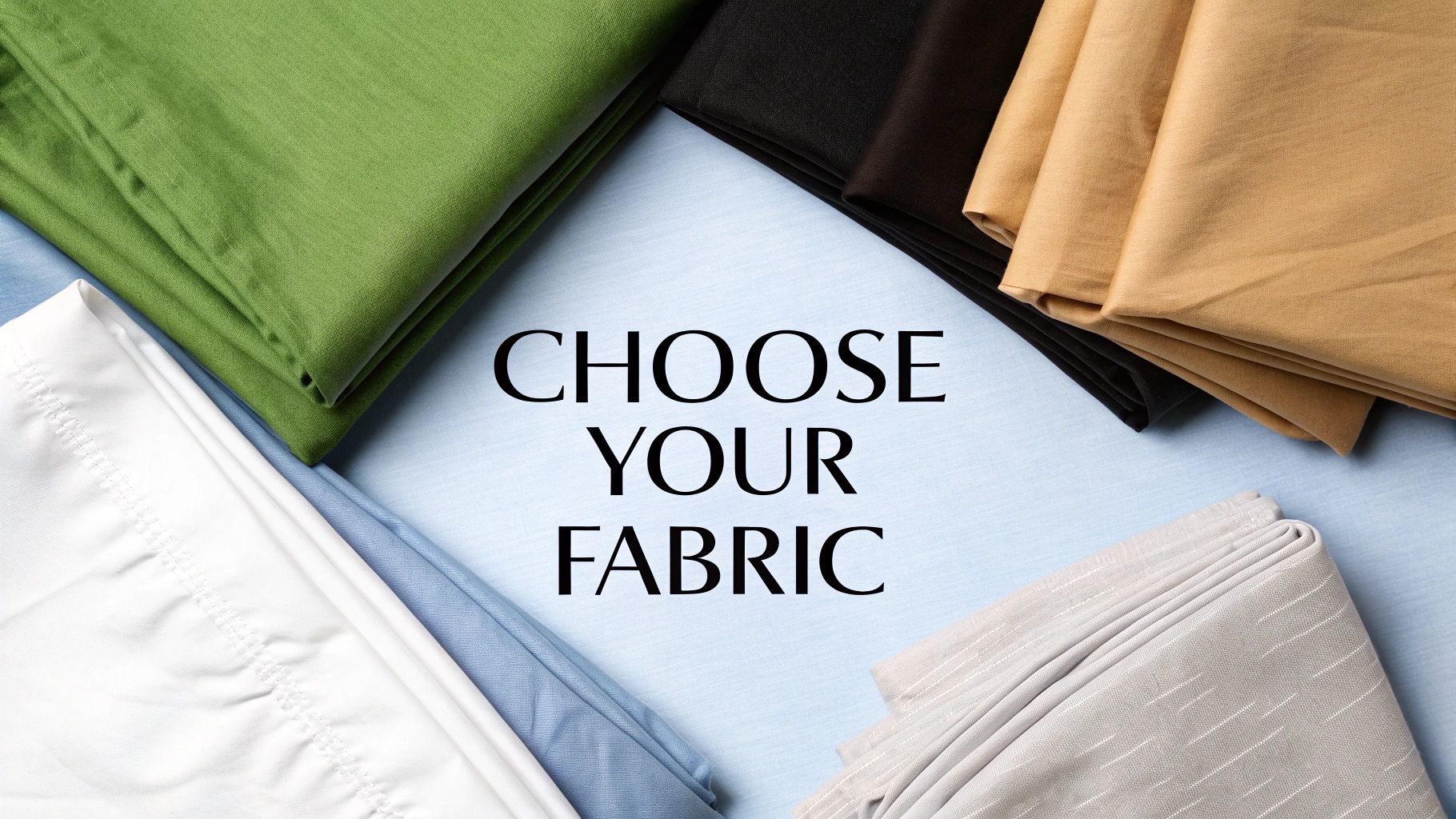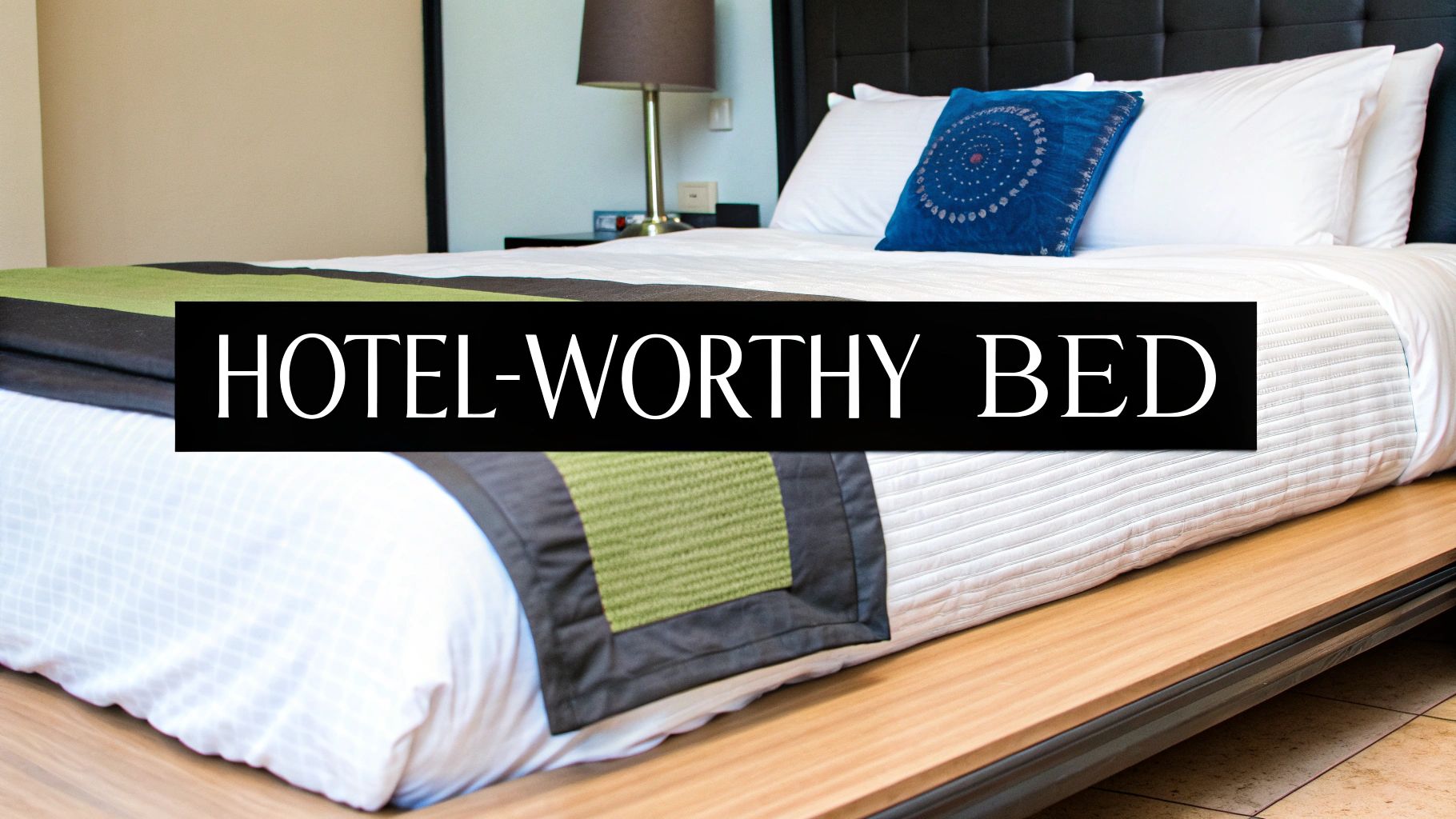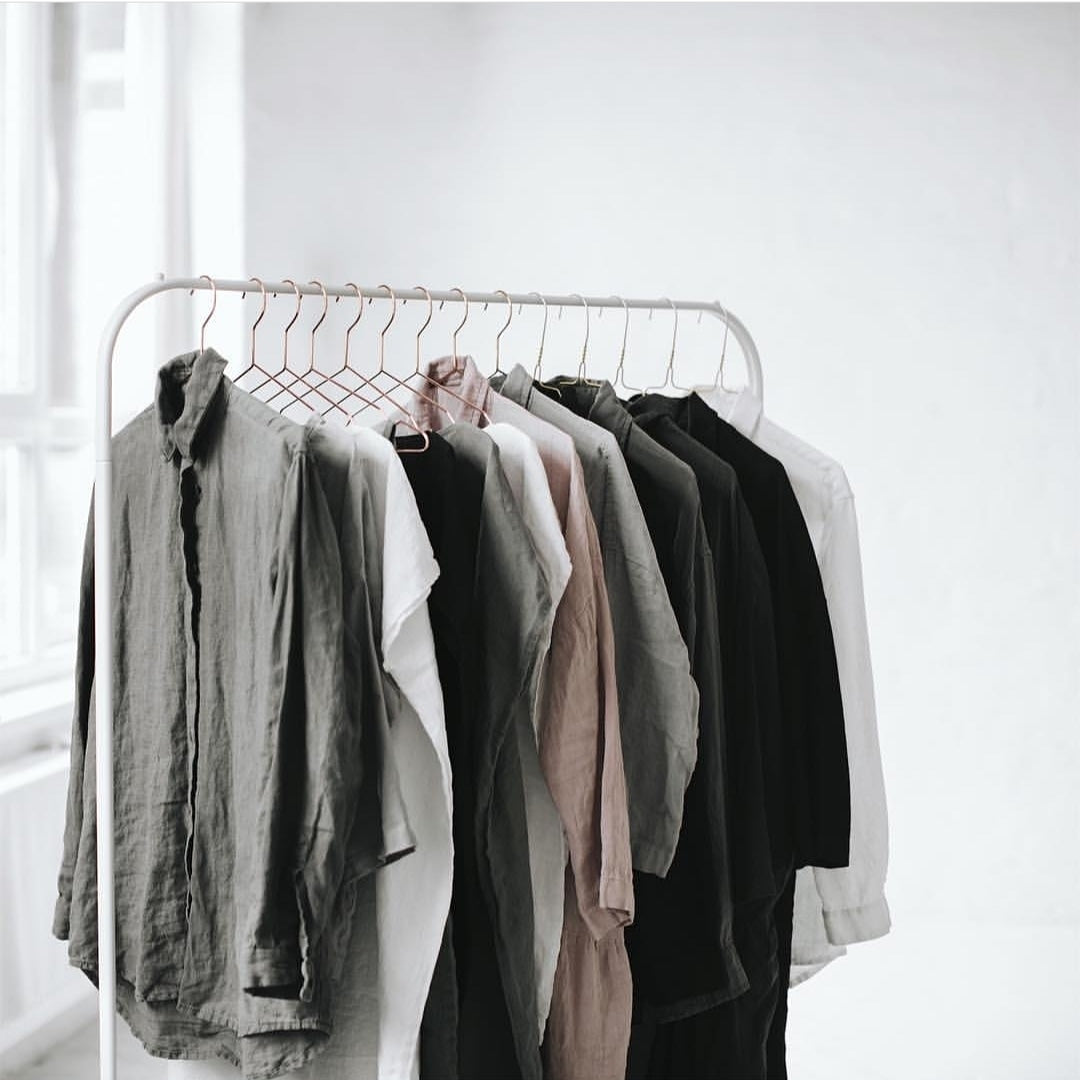Welcome to the ultimate guide for choosing king size fitted bed sheets that actually fit your bed and, just as importantly, your life. A good fitted sheet is the unsung hero of the bedroom—it’s the true foundation for comfort and style. Let's walk through how to pick bedding that turns your bed from just a piece of furniture into the sanctuary you deserve.
The Foundation of a Perfect Night's Sleep
A great night's sleep doesn't just happen when your head hits the pillow. It starts with the very first layer you put on your bed: the fitted sheet. It’s the part you’re in direct contact with all night, and it’s the base for everything else. Yet, for so many Kiwis, it's a constant source of frustration.
We’ve all been there, wrestling with bedding in the middle of the night. Sound familiar?
- The Midnight Pop-Off: You bought a new, deep mattress, but your old sheets just won't stay put, pinging off the corners at the slightest movement.
- The Scratchy Fabric: They felt so soft in the store, but after one wash, they feel more like sandpaper than a soft embrace.
- The Sizing Confusion: Trying to figure out the difference between a standard King and a Super King, or why your sheets are either too baggy or too tight.
Moving Beyond the Frustration
This guide is your way out of the bedding maze. My goal here is to arm you with real, practical knowledge so you can feel confident investing in a set of high-quality king size fitted sheets. We'll demystify confusing terms like 'thread count' and 'percale' and turn them into concepts you can actually use.
You'll get the hang of measuring your mattress correctly, learn what different fabrics really feel like to sleep on, and pick up some simple care tips to make your investment last for years. And it truly is an investment. Kiwis are increasingly prioritising quality in their homes; the national furniture industry is expected to hit $1.5 billion in revenue, with a good chunk of that coming from household textiles like bed linen. You can explore more about home furnishing trends in NZ to see how quality is becoming the main driver for shoppers.
By the time you're done here, you won't just be buying another set of sheets. You'll be choosing the perfect foundation for countless nights of incredible sleep.
Decoding NZ Bed Sizes for a Perfect Fit
Getting the size right is the single most important step when you’re buying king size fitted bed sheets. It’s the difference between a beautifully made bed and a nightly battle with unruly corners that just won't stay put. Think of it like a tailored suit; 'close enough' simply won't cut it, as it ruins both the look and the feel.
Here in New Zealand, the bed size names can be a bit of a minefield. What one person calls a King, another might know as a Super King, and these subtle differences are where things go wrong. Choosing incorrectly means you’ll end up with sheets that are either frustratingly baggy or impossible to stretch over that last corner.
This common frustration is one of many little things—like scratchy fabrics or general confusion—that can get in the way of creating a truly peaceful bedroom.

As you can see, the main roadblocks to a perfect bed—sheets popping off, poor fabric feel, and sizing mix-ups—all come down to a lack of clear, straightforward information.
King vs Super King: The NZ Difference
Let's clear up the biggest point of confusion for Kiwis: the difference between a standard New Zealand King and a Super King. They are definitely not the same thing, and their sheets are sized specifically to match.
Here’s a quick rundown of the standard mattress dimensions you’ll find in New Zealand:
- NZ King Mattress: Typically measures 167cm wide x 203cm long.
- NZ Super King Mattress: Measures 183cm wide x 203cm long.
You’ll notice they share the same length, but the Super King gives you an extra 16cm of width. That might not sound like a lot, but it’s more than enough to make a King fitted sheet impossible to wrestle onto a Super King mattress.
For a deeper dive into all the standard measurements, our comprehensive guide to NZ sheet sizes has all the details.
The Secret Culprit: Mattress Depth
Even if you’ve nailed whether you have a King or a Super King, there's another dimension that trips up almost everyone: mattress depth. This is the secret culprit behind sheets that constantly ping off the corners in the middle of the night.
Modern mattresses, especially those with luxurious pillow tops or integrated memory foam layers, are much deeper than their older counterparts. A standard fitted sheet is often designed for a mattress around 30-35cm deep. If your mattress is 40cm or more, a standard sheet just doesn't have enough fabric to tuck securely underneath.
Your fitted sheet’s pocket depth must be greater than your mattress's total height. As a rule of thumb, aim for at least 5-7cm of extra fabric to ensure a snug, secure tuck that won't slip off.
To get ahead of this problem, you need to measure your mattress height properly.
How to Measure for a Perfect Fit
Grab a tape measure and follow these simple steps. It’ll take less than five minutes and guarantee you buy the right king size fitted bed sheets every single time.
- Measure the Width and Length: Run your tape measure from side to side for the width, and from the head to the foot for the length. This will confirm whether you have a King (167cm) or a Super King (183cm).
- Measure the Total Height: This is the most crucial step. Place a hard ruler or book flat across the top of your mattress so it hangs over the edge. Now, measure from the bottom edge of the mattress straight up to the ruler. Crucially, make sure you include any mattress toppers in this measurement, as the fitted sheet needs to cover everything.
- Find the Right Pocket Depth: With your total height measured, you can now shop smart. Look for fitted sheets labelled as 'deep pocket' or 'extra-deep pocket'. A 'deep pocket' sheet usually fits mattresses up to 40cm, while extra-deep options can accommodate mattresses up to 50cm or even more. Always double-check the product description for the exact pocket depth.
To help you visualise this, here’s a quick-glance table covering standard New Zealand sizes.
New Zealand Bed and Fitted Sheet Size Guide
| Bed Size | Mattress Dimensions (cm) | Standard Fitted Sheet Pocket Depth (cm) | Recommended For |
|---|---|---|---|
| Single | 91 x 190 | 35-40 | Children's beds, compact guest rooms |
| King Single | 107 x 203 | 35-40 | Taller individuals, teenagers |
| Double | 137 x 190 | 40 | Standard guest rooms, smaller master bedrooms |
| Queen | 152 x 203 | 40-50 | Most popular size for couples |
| King | 167 x 203 | 40-50 | Couples wanting extra width |
| Super King | 183 x 203 | 40-50+ | Maximum space, luxury master bedrooms |
| Californian King | 203 x 203 | 50+ | Square-shaped for ultimate luxury |
By taking a few minutes to measure, you completely eliminate the guesswork. You’ll be able to shop with confidence, knowing your new sheets will fit like a glove, stay in place, and create that flawless foundation your beautiful bed deserves.
Finding Your Ideal Sheet Fabric

Beyond the perfect fit, the fabric of your king size fitted bed sheets is what really makes or breaks your sleep experience. This is the material that’s against your skin all night, so finding the right one is less about technical specs and more about how you want to feel.
Think of it like choosing a favourite shirt. Some people live for the crisp, cool feel of a freshly pressed button-down, while others crave the soft, worn-in comfort of a vintage t-shirt. Your sheets should feel just as personal and just as right. Let's walk through the options to find your perfect match.
The Classic Comfort of Cotton
Cotton is the undisputed champion of the bedding world, and for good reason. It’s breathable, tough, and gets wonderfully soft over time. But here’s the thing: not all cotton is created equal. The length of the fibre and the way it’s woven make all the difference.
Interestingly, the New Zealand market for cotton bed linen has been on a bit of a rollercoaster. Recent data showed a massive contraction, with the market value dropping to around $3.8 million—that's a 96.9% dip in just one year. This tells us Kiwis are exploring other materials and responding to things like import costs.
Even with these shifts, you can't go wrong with premium cotton. Here are the names to look out for:
- Egyptian Cotton: This is the gold standard. Its extra-long fibres create yarns that are incredibly strong yet fine, resulting in sheets that are both durable and divinely soft. Best of all, they just get better with every wash.
- Supima® Cotton: Another top-tier choice, Supima® is an extra-long staple cotton grown exclusively in the USA. It’s known for its strength, softness, and knack for holding onto colour, wash after wash.
The weave is your next decision. A percale weave gives you that light, crisp, cool-to-the-touch feeling—an absolute dream if you tend to sleep hot. On the other hand, a sateen weave has a silkier, smoother finish that drapes beautifully and feels a touch warmer and more decadent.
The Rustic Elegance of Linen
Linen, made from the fibres of the flax plant, offers a completely different world of texture. It has a relaxed, subtly textured feel that’s effortlessly chic—think rustic farmhouse meets luxury hotel. It’s also one of the strongest natural fibres out there, so it’s built to last.
Linen’s real superpower is its incredible breathability. It can absorb a remarkable amount of moisture before ever feeling damp, making it the perfect choice for New Zealand’s changeable climate.
It’ll keep you cool and dry on those humid summer nights, but it also provides a surprising amount of cosy warmth when the temperature drops. And the best part? Linen ages beautifully, becoming softer and more supple with every single wash. If you're torn, you can learn more about the differences between linen and cotton sheets in our dedicated guide.
The Silky Softness of Bamboo
If you’re dreaming of a fabric that feels fluid, drapey, and silky-smooth, bamboo is your answer. Sheets made from bamboo viscose are famous for their incredible softness, often compared to high-end silk or cashmere.
This material is a godsend for anyone with sensitive skin. The smooth fibres are naturally hypoallergenic and won't cause irritation. Bamboo is also a master of temperature control.
- Hot Sleepers: The fabric breathes beautifully and wicks moisture away from your skin, helping it evaporate to keep you cool.
- Cold Sleepers: The fibres are great at trapping a thin layer of warm air close to your body, giving you insulation without making you overheat.
This clever adaptability makes bamboo a fantastic choice for year-round comfort.
Modern Eco-Friendly Innovations
The world of textiles is always moving forward, with a huge focus on creating beautiful fabrics that are also kinder to our planet. These modern options offer pure luxury with a clear conscience.
A real standout here is Tencel™ Lyocell. It’s made from sustainably sourced wood pulp (usually from eucalyptus trees) in a "closed-loop" process. This basically means the water and solvents are recycled over and over, dramatically reducing its environmental footprint.
The fabric itself is a dream. It somehow manages to be softer than silk, more absorbent than cotton, and cooler than linen. Its incredibly smooth surface is gentle on skin, and its ability to manage moisture helps stop bacteria from growing, keeping your bed feeling fresh for longer.
Matching Fabric to Your Sleep Profile
Ultimately, choosing the right fabric for your king size fitted bed sheets is all about you. There's no single "best" material—only the best one for the way you sleep.
To find your perfect match, ask yourself a few questions:
- Do you sleep hot or often wake up sweaty? You need something breathable. Go for Linen, percale cotton, or Tencel™.
- Is your skin easily irritated? Look for something smooth and hypoallergenic. Bamboo and Tencel™ are fantastic, as is a high-quality Supima® cotton.
- Do you love that crisp, clean, "hotel bed" feeling? You're describing percale weave cotton to a T.
- Do you prefer a silky, draping, luxurious feel? A sateen weave cotton or bamboo sheet will give you that elegant, fluid sensation.
- Is durability your main concern? You can't beat the longevity of Linen and premium long-staple cottons like Egyptian or Supima®. These are true investments.
By thinking about how you sleep, you can move past the marketing jargon and choose a fabric that will genuinely help you get a deeper, more restorative night’s rest.
Thread Count and Weave: What Really Matters?
When you’re on the hunt for luxurious king size fitted bed sheets, one term always seems to get all the attention: thread count. For years, we’ve been sold the idea that a higher number means better sheets. But what if that’s one of the biggest myths in the bedding world?
The truth is, genuine quality isn’t about a hyped-up number on the packaging. It’s found in the ingredients and the recipe – the quality of the raw cotton and the skill of the weave. These are the two factors that truly determine how your sheets will feel night after night and how well they’ll last.
The Great Thread Count Myth
So, what is thread count, really? It’s simply a tally of the threads woven into a single square inch of fabric. It counts both the lengthwise threads (the warp) and the widthwise threads (the weft). A 400-thread-count sheet, for example, might have 200 warp and 200 weft threads.
That seems simple enough, but here’s where it gets murky. Some manufacturers play a numbers game by using thinner, weaker, short-staple cotton fibres. They twist several of these poor-quality strands together to create a single, multi-ply thread. Suddenly, a 400-thread-count sheet made with two-ply threads is marketed as an 800-thread-count sheet, doubling the number without actually improving the quality.
This marketing trick often leads to sheets that are heavy, coarse, and surprisingly stuffy. They trap heat and feel rough against your skin, which is the complete opposite of what luxury bedding should be.
The Golden Rule of Bedding: A 400-thread-count sheet woven from high-quality, long-staple cotton will feel softer, last longer, and breathe better than an 800-thread-count sheet made from cheap, multi-ply, short-staple cotton.
Why Fibre Quality Is Everything
The real star of the show in any set of luxury sheets is the quality of the cotton fibre itself. Long-staple cottons, like Egyptian or Supima®, produce incredibly long, fine, and strong fibres.
Think of it like trying to spin a strong rope. Would you use a bundle of short, brittle twigs, or would you use a few long, flexible vines? The vines, of course. It’s the exact same principle with cotton.
- Long-staple fibres can be spun into smooth, silky yarns that are naturally strong and resistant to pilling, getting softer with every wash.
- Short-staple fibres have countless tiny ends poking out, which creates a rougher texture and a fabric that breaks down much faster.
This is why it pays to invest in sheets made from premium, long-staple cotton. The quality is woven right in, guaranteeing a beautiful feel that only improves over time. To dive a little deeper, you can learn more about finding the best thread count for sheets and why the fibre is what truly counts.
The Art of the Weave
Just as important as the fibre is the weave—the pattern in which the threads are interlaced. The weave is what gives your king size fitted bed sheets their final feel, look, and performance. The two main players you'll come across are percale and sateen.
Percale Weave
Picture a perfectly crisp, cool, white button-down shirt. That's the essence of percale. It’s made with a simple, straightforward one-thread-over, one-thread-under grid pattern.
- Feel: Light, crisp, and noticeably cool to the touch.
- Finish: A smooth, modern matte look.
- Best for: Hot sleepers, summer nights, or anyone who adores that fresh, five-star hotel-bed feeling.
Sateen Weave
Sateen, on the other hand, uses a different structure—typically one thread under and four threads over. This pattern floats more threads on the surface, creating its signature buttery feel.
- Feel: Silky-smooth and lustrous with a lovely, elegant drape.
- Finish: A subtle sheen that looks and feels incredibly luxurious.
- Best for: Anyone who craves a warmer, more decadent feel and loves being enveloped in softness.
Ultimately, choosing between them comes down to personal taste. Do you want to feel cool and crisp, or silky and cosy? By focusing on fibre and weave, you can confidently ignore the marketing hype and choose sheets that deliver true, lasting comfort.
Styling Your Bed Like a Professional

Your king bed is the undisputed centrepiece of your bedroom. It’s the first thing you see in the morning and the last thing at night, so it ought to look incredible. The humble king size fitted bed sheet is where it all begins—think of it as the canvas for your very own masterpiece.
With a few simple tricks, you can elevate your bed from just a place to sleep into a stunning visual retreat. Styling is all about creating a feeling, and the colour and texture of your fitted sheet are the first brushstrokes. Calming neutrals like oat, sand, or soft grey can turn your room into a serene, spa-like escape. On the other hand, rich, moody tones like charcoal or deep olive introduce a bit of drama and sophisticated comfort.
The Art of Layering
So, how do professional stylists get that plush, inviting look? The secret is layering. A beautifully styled bed creates depth and an almost irresistible urge to dive in. Your fitted sheet is the starting point, but the real magic happens when you start adding more elements.
Start with a flat sheet, then add your duvet or quilt. The key here is to play with different textures and tones. If you’ve chosen a smooth cotton sateen fitted sheet, why not contrast it with the beautiful, rustic texture of a linen duvet cover? For more great ideas on creating that polished aesthetic, you can gain insights from an interior designer who has perfected this art in boutique hotels.
Here’s how to build that hotel-worthy look piece by piece:
- Pillows: Don't just stick to your sleeping pillows. Mix in a couple of decorative European square pillows to build height and dimension at the headboard.
- Throws and Quilts: A beautifully folded quilt at the foot of the bed or a casually draped throw adds that final touch of colour, texture, and warmth. It's the perfect finishing detail.
Mastering Hospital Corners
If there’s one small detail that makes a huge impact, it’s the "hospital corner." This simple folding technique gives your flat sheet a taut, polished, and impeccably neat finish. It’s what makes a bed look sharp and truly inviting. Best of all, it keeps your flat sheet from coming untucked overnight.
Mastering the hospital corner is the secret to a flawlessly made bed. It's a quick, easy skill that elevates the look from homemade to professionally styled, ensuring your layers stay neat and tidy.
To create one, start by tucking the end of your flat sheet under the mattress. On one side, grab the hanging fabric about 30-40cm from the corner and lift it onto the bed to form a triangle. Smooth it down, tuck in the fabric still hanging below it, then neatly fold the triangle down and tuck it securely under the mattress. Do the same on the other side, and you're done
How to Care for Your Bed Sheets
Choosing beautiful **king size fitted bed sheets** is an investment in your comfort. To make sure that investment pays off for years to come, a little bit of care goes a long way. Getting this right will keep your sheets feeling soft, looking vibrant, and lasting much longer.Think of it like caring for a favourite cashmere jumper; you wouldn’t just throw it in a hot wash and hope for the best. A gentle approach is key to protecting those delicate natural fibres.
The Right Way to Wash Your Linens
Before you do anything, take a quick look at the care label. Different fabrics have their own quirks, but there are a few golden rules that apply to most high-quality cottons and linens.
One of the most common mistakes is stuffing the washing machine too full. Your sheets need room to swish around freely to get properly clean. When they're packed in tight, detergent and dirt get trapped in the folds, leading to a less-than-perfect wash.
For the best results, stick to this simple routine:
- Wash Separately: Always give your sheets their own dedicated cycle. This stops them from getting tangled, stretched, or snagged by zips and buttons from your other laundry.
- Choose the Right Temperature: A warm wash, around 40°C, is usually the sweet spot. It’s warm enough to dissolve body oils and grime but gentle enough to prevent shrinking or fading. Save the hot washes for when you need to sanitise sheets after someone’s been unwell.
- Use a Gentle Detergent: Stick with a mild, liquid detergent. Powders can sometimes leave a chalky residue, and harsh chemicals will break down natural fibres over time, making them feel brittle.
Here's a pro tip: use about half the detergent you think you need. Too much soap is hard to rinse out completely, and the leftover build-up can make even the softest Egyptian cotton feel stiff and scratchy.
Drying and Storing for Longevity
How you dry your sheets is just as crucial as how you wash them. The biggest enemy of luxurious natural fibres is high heat—it can scorch and weaken them, shortening their lifespan dramatically.
If you can, line-drying outside is the absolute best method. The fresh air and gentle sunshine are natural sanitisers, and it’s the kindest way to treat the fabric. If you have to use a tumble dryer, always choose a low-heat setting. Pull your sheets out when they're still just a tiny bit damp to prevent over-drying and cut down on wrinkles.
It's also a good idea to skip fabric softeners and dryer sheets. These products coat the fibres in a waxy film that actually reduces their natural breathability and absorbency—the very qualities you paid for! A brilliant alternative is to toss a couple of wool dryer balls into the machine. They soften the fabric naturally by tumbling against it, without leaving any chemical residue behind.
Following these simple steps will ensure your king size fitted bed sheets stay soft, inviting, and beautiful for many nights to come.
Got Questions About King Size Sheets? We've Got Answers.
Choosing the right sheets can feel surprisingly complex, so let's clear up a few of the most common questions we hear. Think of this as your personal cheat sheet for making the perfect choice for your king-size bed here in New Zealand.
How Often Should I Really Be Replacing My Sheets?
There’s no hard and fast rule, as it all comes down to the quality of the fabric and how you look after it. A beautiful set of sheets made from premium fibres like Supima® cotton or pure linen is an investment that can easily last for years if cared for properly.
Forget the calendar. Instead, let the sheets tell you when it's time for a change. Keep an eye out for these tell-tale signs:
- Fabric Thinning: Hold the sheet up to the light. Does it look a bit more transparent than it used to?
- Fading Colours: Has that gorgeous, deep navy started to look more like a washed-out grey?
- Limp Elastic: Is the fitted sheet losing its grip on the mattress corners, feeling loose and baggy?
The moment your sheets start to feel rough or just won't stay put, it's time to retire them. A great pro tip is to rotate between two or three favourite sets—it gives each one a "rest" and really extends their lifespan.
What's the Difference Between a NZ King and a Super King?
This is probably the most important question for Kiwi shoppers, and getting it right is crucial. A standard NZ King mattress is 167cm x 203cm. A Super King, on the other hand, is noticeably wider at 183cm x 203cm.
While they share the same length, that extra 16cm of width on a Super King is a game-changer. It means their fitted sheets are definitely not interchangeable. Before you even think about adding sheets to your cart, grab a tape measure and confirm your mattress size. It’s the only way to guarantee that perfect, hotel-style snug fit.
Ever wonder why your fitted sheets constantly pop off the corners? It’s one of the most common bedding frustrations, and the culprit is almost always a shallow pocket depth. Modern mattresses with plush pillow tops are much deeper than older styles, and a standard sheet just can't stretch far enough to tuck securely underneath. Always measure your mattress height and choose a sheet with a pocket deep enough to handle it.
Is It Worth Investing in Organic or Eco-Friendly Bedding?
For a growing number of us, the answer is a resounding yes. It's no surprise that the New Zealand home bedding market is on the rise, with projected growth of around 6.4% annually between 2025 and 2035. This trend is largely fuelled by people seeking higher quality, sustainable choices for their homes. You can discover more about home bedding market trends on FutureMarketInsights.com.
So, what’s the real benefit? Organic options, like GOTS-certified cotton, are grown without harsh synthetic pesticides. This makes them a gentler choice for the planet and a much better option for anyone with sensitive skin.
Then you have innovative eco-friendly fabrics like Tencel™, made using sustainable, closed-loop processes. Beyond their green credentials, these materials are loved for their incredible softness, breathability, and moisture-wicking properties, all of which directly lead to a more comfortable, refreshing night's sleep.
Ready to build the perfect foundation for your sleep sanctuary? At The Foxes Den, we’ve curated a stunning collection of luxurious Supima® cotton and airo-washed linen sheets, all designed for ultimate comfort and enduring style. Explore our collection and elevate your home today.


